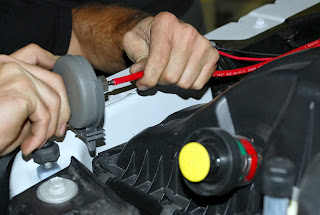The Internet has been a boon to like-minded people. People with similar interests can share in real time, whether they live in Poquoson, Virginia, or Punjab, India. Sometimes, there’s enough interest in a particular Internet group to spark a face-to-face event… and so it has been for the vibrant group in the 6.9L and 7.3L IDI section of the OilBurners.net forum. OilBurners covers a wide range of diesel interests but the Ford/IH IDI section is second to none for friendliness, helpfulness and fanatical devotion to the Ford/IH 6.9 and 7.3L diesels.
For 11 years now, this group has held a get-together in some part of the country. Mel Agne, the owner of an ’83 F-250HD diesel he bought new, has been the driving force in this group of IDI Gearheads and has attended most, if not all, of the rallies. The love of these rigs must be in the genes, as you will see, because the whole family drives IDI-powered trucks.
This year’s event was put on by Ron Butts, a Michigander who grew up with an IDI diesel and would probably like to be able to say he was conceived in one. His father still owns the inspiration, an ’86 F-250, and Ron now has a collection of them. Some 80 people and 32 trucks attended the week-long event at the Indian Creek Camp and Conference Center near Tecumseh, Michigan. People came from as far away as Canada and California to attend the annual get-together.
Events included a convoy to the Henry Ford Museum and Greenfield Village, a tour of the Rouge River Ford truck plant, a Dyno Day and Timing Clinic at Pure Tuning in Toledo, Ohio, and a Show & Shine and swap meet that included firefighting demonstrations from the Ridgeway (Michigan) Township Volunteer Fire Department.
Other activities included a Fourth of July fireworks display, a raffle to benefit the Ridgeway VFD in which a 4-inch IDI performance exhaust, Smittybilt ground anchor, and many other donated products were raffled. A total of $865 was raised for the VFD. Other side trips include a convoy to Cabelas in nearby Dundee and several trips out to eat. Over the course of the event, several impromptu tech demonstrations occurred and valuable information exchanged relating to the care and feeding of the Ford IDI truck.
If you’re a fan of the ’83-94 IDI Ford diesels, visit the OilBurner.net site for information on future events.
Sources:
Indian Creek Camp and Conference Center
www.indiancreekcamping.com
517-423-5659
OilBurners IDI Group
www.oilburners.net
Pure Tuning
www.pure-tuning.com
419-474-7992
By Jim Allen
Photography by Jim Allen & Darrin Tosh
Source: Diesel World Magazine
For 11 years now, this group has held a get-together in some part of the country. Mel Agne, the owner of an ’83 F-250HD diesel he bought new, has been the driving force in this group of IDI Gearheads and has attended most, if not all, of the rallies. The love of these rigs must be in the genes, as you will see, because the whole family drives IDI-powered trucks.
This year’s event was put on by Ron Butts, a Michigander who grew up with an IDI diesel and would probably like to be able to say he was conceived in one. His father still owns the inspiration, an ’86 F-250, and Ron now has a collection of them. Some 80 people and 32 trucks attended the week-long event at the Indian Creek Camp and Conference Center near Tecumseh, Michigan. People came from as far away as Canada and California to attend the annual get-together.
Events included a convoy to the Henry Ford Museum and Greenfield Village, a tour of the Rouge River Ford truck plant, a Dyno Day and Timing Clinic at Pure Tuning in Toledo, Ohio, and a Show & Shine and swap meet that included firefighting demonstrations from the Ridgeway (Michigan) Township Volunteer Fire Department.
Other activities included a Fourth of July fireworks display, a raffle to benefit the Ridgeway VFD in which a 4-inch IDI performance exhaust, Smittybilt ground anchor, and many other donated products were raffled. A total of $865 was raised for the VFD. Other side trips include a convoy to Cabelas in nearby Dundee and several trips out to eat. Over the course of the event, several impromptu tech demonstrations occurred and valuable information exchanged relating to the care and feeding of the Ford IDI truck.
If you’re a fan of the ’83-94 IDI Ford diesels, visit the OilBurner.net site for information on future events.
Sources:
Indian Creek Camp and Conference Center
www.indiancreekcamping.com
517-423-5659
OilBurners IDI Group
www.oilburners.net
Pure Tuning
www.pure-tuning.com
419-474-7992
 |
| The Bricknose/OBS side of the Show & Shine lineup. |
By Jim Allen
Photography by Jim Allen & Darrin Tosh
Source: Diesel World Magazine

















































